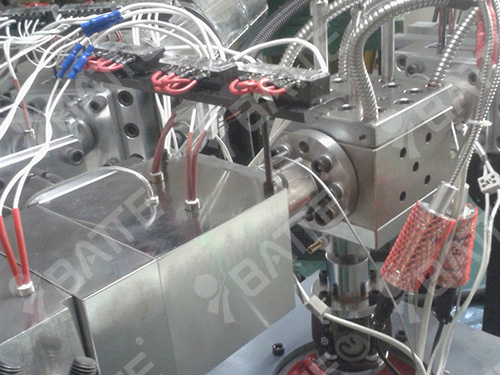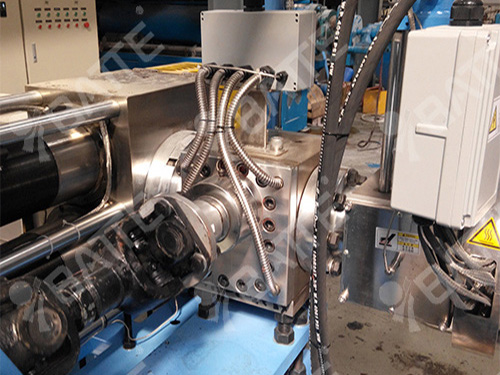Which components of the polymer melt gear pump can be damaged
When the operating temperature is too high, multiple key components of the polymer melt gear pump will be damaged:
Pump body
Changes in metal structure: The pump body is mostly made of metal materials such as cast iron and cast steel. Under high temperatures, the lattice structure inside the metal will change, resulting in a decline in its mechanical properties. For example, when the temperature exceeds the tolerance range of the cast - iron pump body, its strength and hardness decrease. If it is exposed to high temperatures for a long time, the pump body may deform, affecting the overall structural stability of the pump. This will lead to a decrease in the fitting accuracy between the pump body and other components, causing problems such as leakage.
Corrosion aggravation: If the polymer melt decomposes or undergoes chemical reactions at high temperatures, producing corrosive substances, it will cause corrosion to the pump body. For example, certain polymers produce acidic substances during high-temperature degradation, which react chemically with the metal pump body, gradually eroding the pump body and shortening its service life.

Gears
Tooth surface wear: High temperatures can degrade the performance of lubricating oil, reducing the thickness of the oil film, which cannot effectively separate the tooth surfaces of the gears. This leads to increased direct friction between the tooth surfaces and accelerated wear. After long - term operation at high temperatures, problems such as wear, scuffing, and pitting may occur on the tooth surfaces, affecting the transmission accuracy and efficiency of the gears, and ultimately resulting in gear failure.
Change in material properties: Under high temperatures, the metallographic structure of the gear material may change, reducing its mechanical properties such as strength and toughness. For example, for gears made of some alloy steels, high temperatures may change the distribution and morphology of alloying elements, reducing the load - bearing capacity of the gears and making them prone to serious failures such as tooth breakage.
Shaft
Bending deformation: In a high - temperature environment, the yield strength of the shaft material decreases. When the torque and other external forces it bears remain unchanged, it is more likely to bend and deform. The bending of the shaft will 破坏 the concentricity of the pump, resulting in poor gear meshing, increased vibration and noise, and further aggravating the wear of components. In severe cases, the shaft may even break.
Surface damage: High temperatures can also cause surface damage to the contact parts of the shaft with seals, bearings, etc. For example, the friction pair of the shaft and the mechanical seal will experience increased wear at high temperatures, and problems such as grooves and wear steps may occur, affecting the sealing performance and leading to melt leakage.

Seals
Aging of rubber seals: If rubber - type seals such as O - rings and oil seals are used inside the pump, high temperatures will accelerate the aging process of the rubber. The rubber seals will become hard, brittle, and lose their elasticity, unable to effectively fill the sealing gaps, thus resulting in the leakage of polymer melt. For example, the service life of nitrile rubber seals will be significantly shortened in a high - temperature environment.
Failure of mechanical seals: For mechanical seals, high temperatures can vaporize the lubricating fluid film on the sealing surface, destroying the lubrication and cooling conditions of the sealing surface, leading to dry friction on the sealing surface and increased wear. At the same time, high temperatures may also reduce the performance of the elastic elements (such as springs) of the seals, making it impossible to maintain the normal specific pressure on the sealing surface, ultimately resulting in seal failure.
Bearings
Decline in lubrication performance: High temperatures can reduce the viscosity of the bearing lubricating oil, making it impossible to form a good oil film between the bearing rolling elements and the raceway. This leads to increased friction, the generation of more heat, and further aggravation of bearing wear. For example, when the oil temperature is too high, the oiliness and extreme - pressure performance of the lubricating oil decline, and the wear rate of the bearing will increase significantly.
Deterioration of material properties: The mechanical properties of the bearing metal material deteriorate at high temperatures, with reduced hardness and load - bearing capacity. After long - term exposure to high temperatures, problems such as fatigue spalling and wear may occur on the bearing raceway and rolling elements, affecting the rotation accuracy and service life of the bearing. In severe cases, the bearing may seize, preventing the pump from operating normally.
Email: info@battemachinery.com
WhatsApp: +86 158 38331071